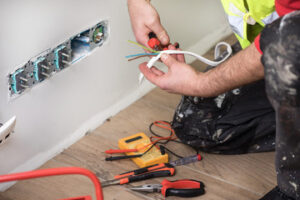Ceiling Insulation Perth reduces energy loss, making your home more comfortable year-round. It also minimizes temperature fluctuations and offers soundproofing benefits.

Adding insulation during construction gives you the option of choosing from several options, including batts, blown-in products, and spray foam.
The energy efficiency of a building is an important concern for modern homeowners, and installing ceiling insulation is one way to improve home efficiency. In addition to reducing the cost of heating and cooling, it can also protect against drafts, reduce outside noise levels, and prevent condensation that may lead to mold.
Insulation is made of materials that inhibit conductive heat transfer between rooms or floors. It is installed in the attic or ceiling space of a house, and there are various types of insulation available depending on the home’s needs. Loose fill insulation, for example, is blown into the attic space and conforms to the space to create an even layer. This type of insulation is ideal for attics and hard-to-reach areas.
During the winter, warm air will leak through uninsulated ceilings and escape into the colder areas of the house. This places a heavy burden on heating systems to maintain the temperature of your living spaces. In the summer, radiant heat can enter through uninsulated roofs and push your air conditioning to work harder. Ceiling insulation, however, can help you cut down your energy bills by keeping your house at a comfortable temperature all year round.
Installing ceiling insulation is a fairly easy process that can be completed with minimal disruption to the living space. You can either do it yourself with loose-fill insulation, which is rolled out or blowed into the attic space like blanket-style batting, or you can hire an attic services professional to complete the job. If you’re considering an DIY option, it’s worth remembering that a gap in your insulation is going to reduce its effectiveness significantly, so you’ll need to seal any gaps before applying the insulation.
It’s a good idea to insulate between floor spaces in two-story homes as well, especially if you have ducts running through the attic. Insulating these areas will also help prevent duct leaks. In addition, the acoustic properties of some insulation materials can help reduce external noise levels, making your home a quieter place to live.
Better Comfort
If you live in a home with a crawl space or attic, you can insulate this area to reduce the amount of heat that is lost from the upper level of your home. Insulating the attic helps to keep the heat from escaping during the NEPA winters, and it will also reduce energy costs by keeping your HVAC system working less. Proper ceiling insulation will also help to maintain consistent indoor temperatures throughout the year, leading to lower utility bills and greater comfort in your home.
There are many options available for insulating your home’s ceiling, depending on the type of construction and the desired thermal performance. The most popular and cost-effective solution is fiberglass batt insulation, which comes in pre-cut panels that are easily installed by non-specialists. The material is made from recycled glass and mineral wool, and it offers superior thermal performance that is effective at reducing heat transfer. It is also fire-resistant and non-toxic, making it ideal for use in residential settings.
Other insulation materials are available for use in ceilings, including shredded cellulose, polyester, and spray foam. The latter is a popular option for newer homes, as it can provide a more streamlined installation process that requires less access to the attic area. Spray foam is a self-expanding polyurethane material that can fill in gaps and crevices, creating an airtight barrier that prevents drafts and enhances energy efficiency. It is also moisture resistant, which makes it a great option for areas of the home that are prone to humidity.
In addition to enhancing the thermal performance of your home’s ceiling, insulating it will minimize noise from outside and between floors, making for a more peaceful living environment. Specialized acoustic insulation products are also available for the ceiling, which can further improve your family’s comfort by minimizing sound transmission between rooms. If you are thinking about insulating your ceiling, speak with an experienced home improvement professional to discuss the best options for your specific situation. This will lead to faster, higher-standard results and valuable product recommendations tailored to your home’s needs.
Reduced Energy Bills
Insulation slows the transfer of heat in and out of a home, which allows for a more efficient use of heating and cooling systems. This means that homes with better insulation can reduce energy bills by up to 15%, depending on where the property is located and how much heating or cooling is needed. This reduced consumption of power also helps to conserve energy resources and protects homeowners against rising electricity prices.
Having proper ceiling insulation in place helps to keep outside temperatures out, allowing for comfortable indoor living and reducing the need to run heating or air conditioning at full capacity during cold NEPA winters and hot NEPA summers. It can also help to lower greenhouse gas emissions and make for a more sustainable home and construction.
Ceiling insulation is a cheap investment with significant long-term benefits and is an integral component of eco-friendly building practices and environmentally responsible living. In addition, it is important to note that insulating the roof of your home may qualify you for government rebates and tax credits.
If you are considering insulating your home, it is important to consult a professional who can assist you in finding the right solution for your unique situation and budget. There are a variety of options available for homeowners in the Brisbane and Northern New South Wales area, including cellulose and spray foam insulation.
Cellulose insulation is an eco-friendly and cost-effective option for insulating the ceiling of your home. It is made from recycled paper products that have been treated for fire resistance and provides an effective thermal barrier that keeps your home warm in the winter and cool in the summer. It is also a great choice for homes with uneven or difficult to reach areas, as it can be blown into the spaces in between joists.
Spray foam insulation is the most effective form of insulation for the ceiling, providing an airtight seal and significantly reducing drafts. This type of insulation is also stronger and more durable than other types of insulation, meaning that it can last the lifetime of your home.
Increased Value
Adding ceiling insulation is one of the best ways to increase your home’s value. Energy-efficient homes are becoming increasingly popular among buyers, and a well-insulated home can help you sell your property faster. Potential buyers will also be willing to pay more for a home that is already energy-efficient, which can save them on utility bills in the short term and long term.
Insulation offers a great return on investment, and it is an inexpensive way to add value to your home. In fact, according to Remodeling Magazine’s Cost vs. Value report, insulation is the number one home improvement project in terms of its ROI.
The acoustic and thermal properties of ceiling insulation can greatly enhance your home’s comfort and value. If you’re in the process of building a new home, installing insulation during construction is easy and cost-effective, but it can be done in existing homes as well.
Proper ceiling insulation helps to reduce sound transmission between floors and rooms, as well as outside noises. This can help to create a quieter and more peaceful home environment, which is a big benefit for families and pets. It can also improve indoor air quality by reducing pollutants and moisture in the air.
In addition to reducing energy costs and increasing comfort, ceiling insulation also adds value to your home by making it more environmentally responsible. This can be a huge selling point for many potential buyers, as it shows that you care about your impact on the environment.
The installation of attic insulation can be completed in a variety of ways depending on the phase of construction, the type of attic space, and the materials used to build your house. During the construction phase, batt insulation can be installed between floor joists, and blown-in products can be added after drywall sheets are attached. However, it is important to remember that if you’re planning to install ceiling insulation in an existing home, thorough inspection of the current insulation should be undertaken prior to installation to ensure that it is not compromised or damaged.


